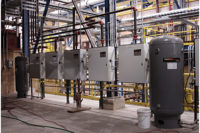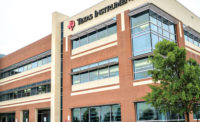Kentucky-based North American Stainless (NAS) faced unique challenges in designing a fire-suppression system for a new production line, and three existing lines, for annealing and pickling stainless steel in its facility.
The new line, dubbed AP4, is one of the largest units of its type in the world, with an annual rolling capacity of more than 1.2 million tons. With more than 200 ft. of pickling line to protect, both total flooding and local application solutions were required. As a result, NAS needed a system that could meet all its specialized requirements, such as:
- Protection of sensitive motors and controls without using large quantities of water;
- Effectiveness in corrosive environments;
- Open-space effectiveness without requiring room integrity;
- Minimum facility downtime following system discharges; and
- Design flexibility for future facility expansion and ease of maintenance.
The scope of requirements led NAS to 3S Inc., a special hazards fire system company that provides industrial and commercial customers with custom-engineered fire protection solutions, including specifications, system design and fabrication, project management and installation, and service and inspections.
3S specified Victaulic’s Vortex 1000 Fire Suppression System in combination with electronic detection equipment and manual pull stations. The Vortex system is a twin-fluid hybrid system that combines two fire-suppression technologies — inert gas and water mist — both to absorb heat and extinguish fire.
Minimal water presence
The NAS pickling line application required minimal water be released from the fire-suppression system because excessive wetting would damage motors and controls, fill accumulator and motor drive pits, and cause expensive damage and downtime on the lines.
3S found the Vortex system discharges water droplets less than 10 microns in diameter, or nearly 100 times smaller than drops delivered by a traditional sprinkler system. The emitter discharges a blend of nitrogen and approximately 1 gal. of water per emitter per minute. For the pickling line, the average zone of protection is 3,200 sq. ft. and includes 30 emitters. This means the emitters dispense approximately 45 gal. of fine water mist mixed with nitrogen in just 90 seconds during a full zone discharge. In comparison, a high-pressure water system would discharge approximately 360 gal. in those same circumstances, and a deluge system would discharge more than 19,000 gal. over a 20-minute span.
”Vortex delivered the performance without the water damage,” 3S President Tom Euson notes. “In fact, most of the system testing after installation was conducted with the lines running. There was no damage to motors and controls, and there was no water accumulation on the floor.”
NAS New Installations Manager Tom Heckard adds, “This was the obvious choice to use in our new production line because our systems are so sensitive to large quantities of water.”
Heckard acknowledges false system trips can be possible in a fire system in the pickling line’s environment, but he notes false trips with deluge systems can add up in cost and downtime. “We don’t have to worry about flooding,” he says.
Effectiveness of the new system comes through a combination of low-pressure discharge and high-velocity delivery. Water is introduced into a supersonic jet stream of nitrogen and then delivered into the hazardous space at 40 mph. Because nitrogen and water are blended at the emitter and distributed to the hazard together, the result is hybrid fire suppression — heat absorption and extinguishing.
The system features a low operating discharge pressure of approximately 25 psig at the system emitter. Most high-pressure water mist systems operate at 1,500 to 2,500 psig, and inert gas systems operate at 2,500 psig. The low discharge pressure of the system in the pickling line environment allowed the use of plastic pipe for both the nitrogen and water. The specially designed emitters for under the tank covers were made from PTFE/PVDF. This would not have been possible with a CO2 or high-pressure water mist system and was essential due to the corrosive nature of the pickling line environment.
Other benefits
Typical mist systems require room integrity because of the low-velocity delivery of the material, which can disperse due to air resistance and not reach the fire plume. The new system distributes at high velocity and over a great distance in a vortex pattern that envelopes the hazard, even in open space. Victaulic tests have proven the effectiveness of the system on small fires in large spaces. This was a key concern in the open-space environment of the pickling line and became a key advantage of the system for the NAS application.
For NAS, an additional benefit is the quick system recharge. Each pickling line has three to six discreet zones of coverage with the capability of discharging exterior and corresponding interior zones simultaneously. There is enough nitrogen — stored in bulk tanks central to the lines — for 100% redundancy for the largest zones. The entire system resets in minutes and the nitrogen can be rapidly replenished. In the event of a discharge, only lines where the hazard occurred need to shut down for system reset, which translates to minimum facility downtime.
During installation at NAS, two of the four lines were older and had limited space for mounting equipment, which proved to be a challenge for installers. With machinery in operation during the install, some areas could not be accessed until the line was down. Given the shape and nature of the machinery, the Vortex system piping had to be designed with low impact. The system is integrated with the support structure of the process line itself, avoiding overhead cranes and piping into the acid tanks. The piping is designed so it can be disassembled and removed during normal facility maintenance functions such as roll replacement.
With a centralized bulk-tank nitrogen supply, the system is designed for future expansion as required, whether an additional process area or another pickle line.
Heckard notes there were “no surprises” while attending the commissioning of the new system, which provides a practical and cost-effective solution for the plant.
Frank Barstow is a Vortex sales representative with Victaulic. He has more than 35 years of industry experience, including owning his own contracting firm. Barstow is a member of NFPA, AFSA and has been involved in the research and development of many Victaulic products.





